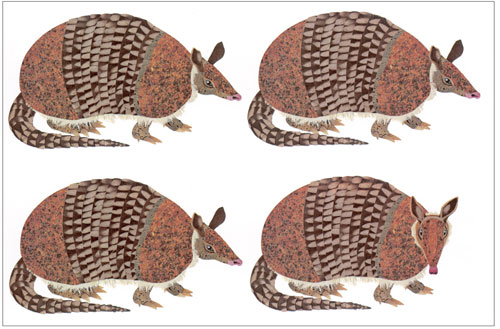
This Article From Issue
November-December 2008
Volume 96, Number 6
Page 523
DOI: 10.1511/2008.75.523
The arrival of a sibling can be a big event, and a big annoyance, in any child's life. But how about having three siblings, all genetically identical, as nine-banded armadillos do? Picturing herself as one of a set of identical quadruplets (shown) could give a child a whole new perspective on the world. In Sisters and Brothers: Sibling Relationships in the Animal World (Houghton Mifflin Company, $16, ages 5 to 8), Steve Jenkins and Robin Page pack in fascinating facts about all kinds of animal siblings.
For instance, New Mexico whiptail lizards give birth only to girls, all of which are clones of their mother. Wild turkey brothers stay together their entire lives, with the largest as the leader. Peregrine falcon siblings practice hunting together, taking turns being the target. And hatching baby alligators cheep in unison so that a parent will hear them and help them break out of their shells. The authors also illustrate hierarchies in large colonies, the function of play among siblings and the ways groups of siblings work together to stay safe.

From Sisters and Brothers: Sibling Relationships in the Animal World by Steve Jenkins and Robin Page.
Jenkins and Page don't leave out the rough stuff, from siblings killing one another in fights to cannibalism—although they explain these things in the context of being best for the species. They also talk about surrogate siblings—bird and animal hatchlings raised from eggs left in the nests of other species.
Sisters and Brothers is illustrated with the authors' signature paper collages, whose slightly abstract look is very engaging visually. A section at the end offers additional facts about each species, a good jumping off point for young readers who may wish to know more about these interesting creatures.
American Scientist Comments and Discussion
To discuss our articles or comment on them, please share them and tag American Scientist on social media platforms. Here are links to our profiles on Twitter, Facebook, and LinkedIn.
If we re-share your post, we will moderate comments/discussion following our comments policy.